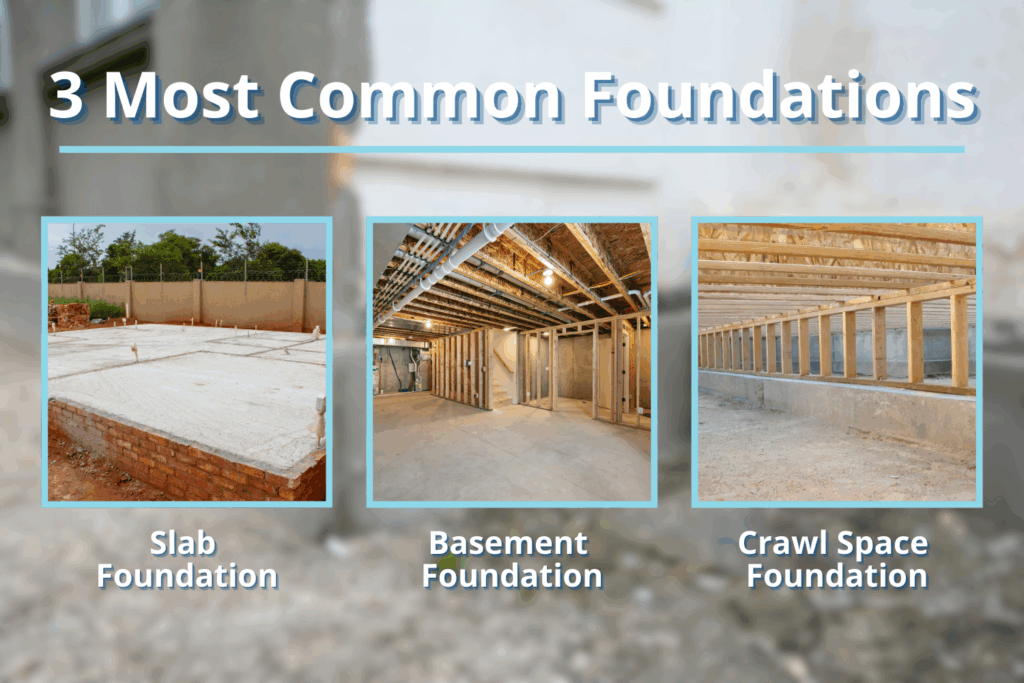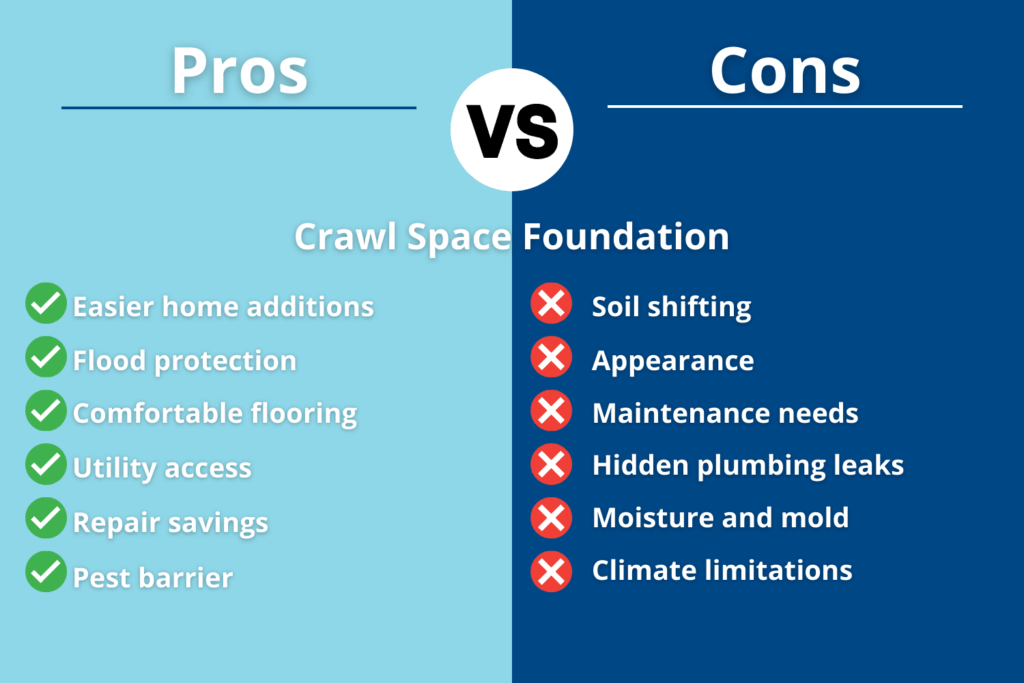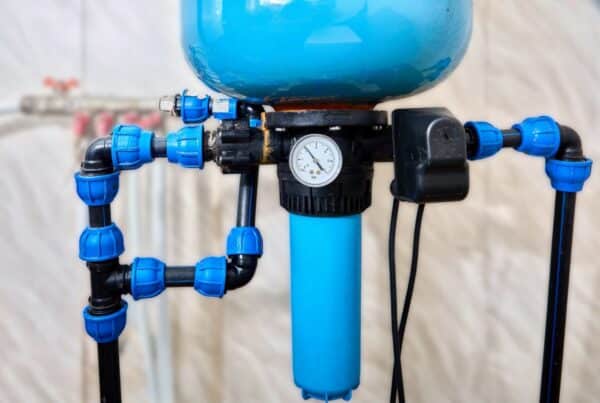
A crawl space foundation is a type of home foundation that raises a house off the ground by about 1–3 feet. It’s built using poured footings and short walls or piers, creating a small space beneath the home. While you can’t stand up in this area, it provides easy access to plumbing, electrical, and HVAC systems that run underneath the house.
If you’re buying a home, considering a remodel, or just trying to understand your property better, knowing what a crawl space foundation is can help you make smarter decisions about upkeep, costs, and long-term value.
Crawl Space Foundation vs. Other Home Foundations
Not all homes are built with the same type of foundation. In the U.S., the three most common options are slab foundations, basement foundations, and crawl space foundations. Each has pros and cons depending on the climate, soil, and budget.
- Slab foundations are built by pouring a solid concrete slab directly onto the ground. They are affordable and low-maintenance, but they make it harder to repair or upgrade plumbing and wiring because everything is sealed under concrete. Slabs are common in areas where flooding and soil movement are not major issues.
- Basement foundations extend deep into the ground, often beyond the frost line, to provide stability in colder climates. They can add valuable living or storage space, but are more expensive to build and more prone to water intrusion if not sealed properly.
- Crawl space foundations fall in the middle. They don’t offer the living space of a basement, but they give easier access to systems compared to a slab. They’re also elevated, which helps with minor flooding concerns.
Historically, crawl spaces were more common in older homes when building materials were limited. Builders found them to be a practical way to stabilize a home without pouring an expensive, full basement. Today, crawl spaces remain popular in the Southeast and other warmer regions of the U.S.

Types of Crawl Space Foundations
There are two main designs for crawl space foundations, and knowing the difference can help you understand how your home is supported.
Block and Base
- Built with stacked blocks, stones, bricks, or wooden beams that form piers to support the home.
- Leaves gaps around the perimeter, often without cosmetic skirting, which can expose the crawl space to the elements.
- More common in older homes or in rural settings.
Pier and Beam
- Uses a series of concrete piers or brick supports placed firmly in the ground.
- The perimeter of the home is enclosed with walls that include ventilation openings.
- Allows airflow under the house to prevent moisture buildup.
- Considered a more modern and durable version of crawl space construction.
Both designs serve the same purpose, raising the house slightly above the ground. However, pier and beam systems usually offer better protection against shifting and moisture problems compared to open block and base designs.
Pros of a Crawl Space Foundation
Crawl spaces provide several advantages, which is why they remain a popular choice for many homeowners and builders.
- Easier home additions: If you ever want to expand your home, crawl spaces make it easier to add on or adjust the foundation compared to a slab.
- Flood protection: Because the home is elevated, water from heavy rain or minor flooding is less likely to damage the main floor of the house.
- Comfortable flooring: Homes built on crawl spaces often have wooden floors, which feel warmer and softer underfoot compared to concrete slabs.
- Utility access: Repairs to plumbing, wiring, or ductwork are simpler and less costly because professionals can access these systems without breaking through concrete.
- Repair savings: If the foundation does shift or settle, leveling or repairing a crawl space foundation is usually less expensive than fixing a full basement.
- Pest barrier: A well-maintained crawl space with proper ventilation and encapsulation can act as a buffer zone, making it easier to detect and prevent pest infestations before they reach your living areas
Cons of a Crawl Space Foundation
While crawl spaces have benefits, they also bring challenges that homeowners should be aware of.
- Soil shifting: In areas with unstable soils, crawl spaces can be more vulnerable to structural movement than slabs or basements.
- Appearance: Crawl spaces can make the outside of a home look less polished unless skirting or landscaping is added.
- Maintenance needs: They require consistent upkeep, especially with moisture control and pest prevention.
- Hidden plumbing leaks: Because plumbing runs under the house, leaks can go unnoticed and cause damage over time.
- Moisture and mold: Poor drainage or ventilation can lead to damp conditions that promote mold, mildew, and even pest infestations.
- Climate limitations: Crawl spaces are not well suited for colder regions where deep frost lines can compromise their stability.
If you’re considering buying a home with a crawl space, weighing these pros and cons can help you prepare for long-term maintenance costs and potential repairs.

How Much Does a Crawl Space Foundation Cost?
The price of a crawl space foundation depends on the size of the home, soil conditions, and materials used. On average, homeowners can expect to pay around $5-$16 per square foot.
By comparison, slab foundations average around $4-$14 per square foot, making them significantly cheaper to build. This cost difference explains why many modern builders choose slabs when possible. However, crawl spaces can pay off in convenience and flood protection over time.
How to Maintain a Crawl Space Foundation
Crawl spaces need regular care to stay dry, clean, and structurally sound. Here are the most important steps:
- Moisture control: Install vapor barriers, drainage systems, and dehumidifiers if necessary. These steps help prevent mold, wood rot, and pest problems.
- Ventilation: Make sure vents remain clear to allow airflow, or consider encapsulation if you live in a humid climate.
- Routine inspections: Check for cracks, leaks, or signs of structural shifting. Look for damp spots, sagging insulation, or musty odors that may point to hidden issues.
- Clean the space: Remove debris, old insulation, or pest nests. Encapsulation can help keep the space cleaner long term.
- Insulation upgrades: Proper insulation around walls and ductwork improves energy efficiency and prevents pipes from freezing in cooler climates.
A neglected crawl space can quickly lead to bigger problems inside the home, so regular upkeep is an investment in your home’s long-term stability.
Related Questions
Can a Crawl Space Be Used as Living Space?
No. Crawl spaces are too small for living or storage of valuables. They’re meant for ventilation and access to utilities, not as finished living areas.
What Happens if a Crawl Space Foundation Fails?
Failure may show up as uneven floors, wall cracks, or doors that won’t close properly. Moisture damage is another warning sign. In severe cases, repairs may require lifting and stabilizing the home, which is why routine inspections are critical.
Is It Worth Upgrading an Old Crawl Space?
Yes. Encapsulation, insulation, and pest prevention can extend the life of the crawl space and reduce energy costs. Many homeowners also report improved air quality after sealing or encapsulating their crawl space.
Do Crawl Spaces Attract Pests?
Unfortunately, yes. Damp, dark spaces are inviting for rodents, termites, and insects. Regular pest control inspections are recommended if your home has a crawl space foundation.
Conclusion
While crawl spaces offer clear advantages, they also require ongoing care to prevent moisture problems, pests, and structural issues. For homeowners, understanding your foundation type helps you stay ahead of potential problems.
That’s where Boggs Inspection Services can help. We specialize in providing thorough home inspections that give you peace of mind. From evaluating crawl space foundations to checking for moisture, pests, or structural concerns, our team ensures your home is safe and sound.



